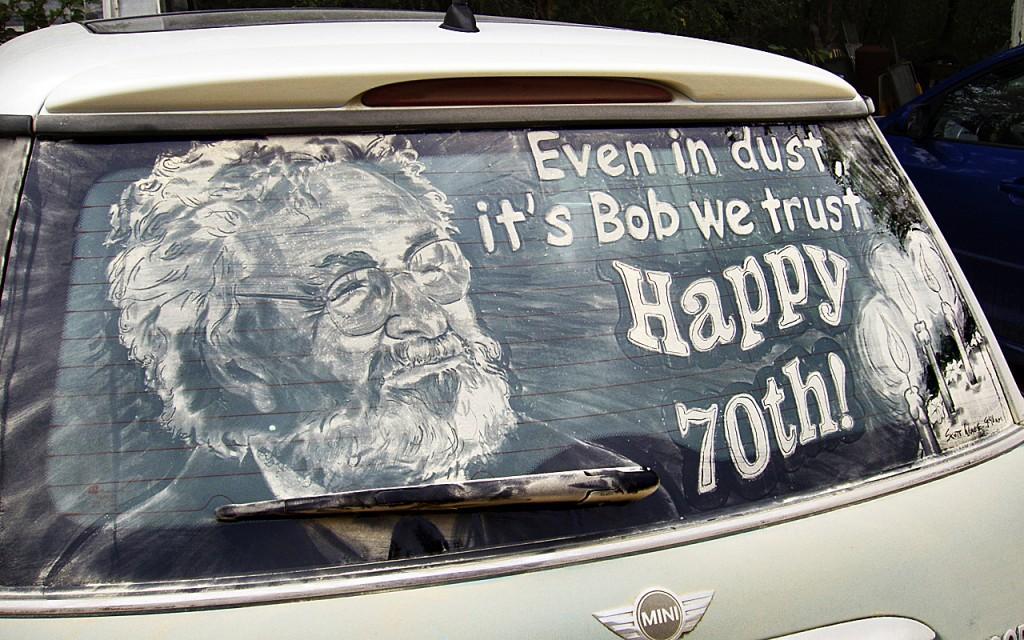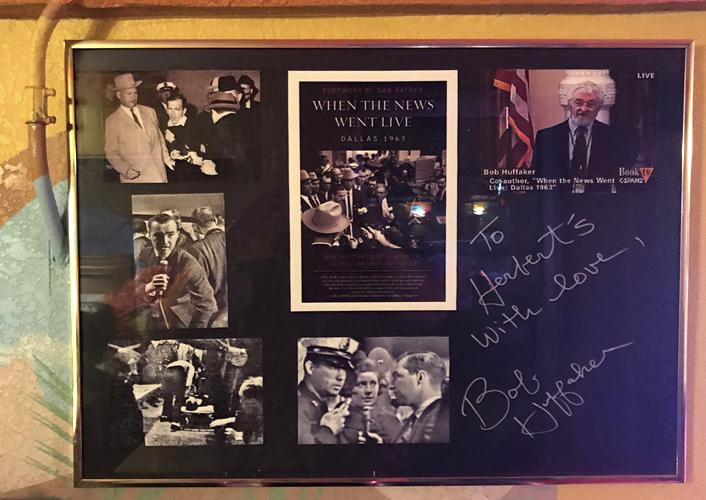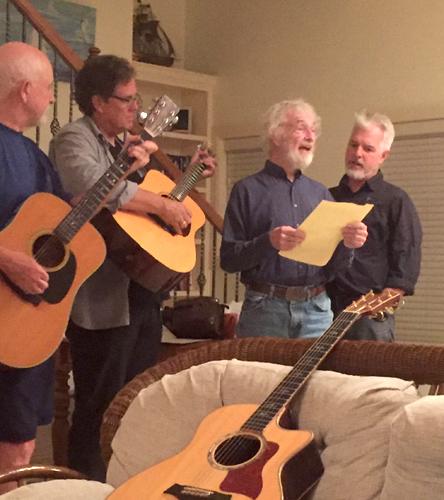
San Marcos’ own “Dirty Car Art” guy Scott Wade created this windshield image of Bob Huffaker on the occasion of his 70th birthday. Photos courtesy of Kevin Huffaker and Tracie Ferguson.
Bob Huffaker was a man of many ‘hats’
Robert S. Huffaker was a journalist, radio broadcaster, English professor, an author, a police officer, and a musician. He was foremost a kind, loving, endearing gentleman with a heart made of gold. He was a loving husband, a dedicated father who adored his wife, his son and his step-son, and his extended family of friends that surrounded him. Huffaker passed away on June 25 after a valiant battle with a cancer, a disease that he had beaten at least two other times.
I first met Bob Huffaker in 1979 through a circle of musical friends centered around an acoustic local San Marcos band known as “Beacon City Band.” Denice Franke of the BCB first introduced me to him. He was an English professor at Southwest Texas State University at the time, and several of the band members had taken his courses. Huffaker, who had a great love for music, would often go see them perform at Grin’s Restaurant, and afterwards the band and their friends would go over to his house for pickin’ and grinnin’ sessions on his front porch, affectionately referred to as “choir practice.” It was a great front porch attached to an old fixer-upper house in San Marcos, a house he fondly called, “The Bishop Street Palace.”

A tribute to Huffaker adorned the wall at Herbert’s Restaurant in San Marcos.
I never took an English course from Bob Huffaker. I dropped out of college early in the game, in order to pursue a career working in music. Still, we became good friends. Initially, our friendship developed through music, but we shared a mutual love for the San Marcos River, in which we all spent many days (and nights) swimming to cool off from the Texas heat. Those of us that live here know that the San Marcos River offers a healing and somewhat mystical experience when you touch its waters. His son, Kevin Huffaker, would later co-produce the highly acclaimed and award- winning documentary on the river, called Yakona (translation “Water Rising” - released in 2014, and recently inducted into the Sundance Film Collection: Fix This Planet ). We also shared a love for dogs, and Kevin’s Golden Retriever named Flower, gave us unyielding affection and rock throwing entertainment in the river for many years as she’d dive to the bottom only to emerge with a much larger rock than was thrown.
When the news went live
In those precious early years, I was unaware of Huffaker’s storied past, and he seldom talked about it, though there was little doubt that he could talk wallpaper off a wall when he wanted to. He had a gift for speaking, anywhere, anytime. He was interesting and his voice was comforting. Eventually I learned that in the early 60s, he’d worked as an investigative reporter for KRLD News radio/TV in Dallas and played a key role in the broadcast coverage of the assassination of President John F. Kennedy from the motorcade to Parkland Hospital. He was present and broadcasting live when Jack Ruby shot Lee Harvey Oswald in the basement of the Dallas Police Department, and he later interviewed both Ruby and Oswald’s mother. The experience was traumatic for him, and it remained dormant for many years before he would talk about it. Years later, Huffaker wrote a book of his experience, enlisting the help of three other colleagues that shared that time of the events: Bill Mercer, George Phenix, and Wes Wise. Dan Rather wrote the forward to it. Called When the News Went Live, it was first published in 2004 and tells the story of what it was like to be an on-the-scene reporter during the time, without all of the technological means of communication that we have now. Huffaker, KRLD, and CBS earned the nation’s highest honor for their on-the-scene reporting that day, presented by the Radio Television News Directors Association.
Huffaker also wrote a widely cited and influential book about the British novelist, John Fowles, first published in 1980 and reprinted in 2010 as “John Fowles: Naturalist of Lyme Regis.”
Huffaker left broadcasting in 1967, to earn his M.A. and Ph.D. from North Texas State University. In earlier years, he’d studied English and earned an Army commission from Texas A&M. He played clarinet in the Aggie band and then spent a year in the U.S. Army Transportation Corps. He eventually landed a job as a Professor of English at SWTU (now Texas State U.) and served as Director of Student Publications. He was honored in 2004 for his work with the University newspaper and was an initial inductee into the University Star’s Journalism Hall of Fame. Other honors include recognition by the Press Club of Dallas in 2011 as a Living Legend of North Texas Journalism, and that same year he was inducted into the Bryan, Texas, Independent School District’s Hall of Fame. After leaving his job at SWTU, he ventured back into broadcasting at the local San Marcos radio station, and then moved to Austin for a job as an assistant editor with the magazine Texas Monthly.
Settling on the river
Around the same time Huffaker bought the Bishop Street Palace in the late 70s, he also acquired a tract of land outside of the San Marcos city limits. Having an affinity for old, unwanted objects of all kinds, and a special love for early American architecture, he spotted a run down house sitting on the banks of the San Marcos River at what is now Sewell Park, set for demolition. He bought and moved the structure out to his land and began what was to become a 20-year restoration project. The music gatherings, still dubbed as “choir practices,” moved out to the new place and were often preceded by a day of paint scraping or other restorative projects to the house. Hal Ketchum, an excellent carpenter and good friend to Huff, came over and built the charming kitchen cabinets, and he sat around the campfire more than once trying out his newly- written songs on us. When he hit the big time in 1991, none of us were surprised.
It was those choir practices that spawned the making of the “Texas Summer Nights” album, a collection of songs I put together, written and performed by the San Marcos based musicians that I knew at the time and had heard at these events. Huffaker, fully thrilled and proud of the whole project, wrote the liner notes for the album, and later served as emcee for the nearly 25 years of album releases, reunions and concerts, which we held at Gruene Hall every year.
If not for Huffaker-inspired choir practices, and this group of musicians, I most likely would never have produced an album, nor have landed the job of booking bands for Gruene Hall, a job that I’ve been at for 36 years now.
A romantic turn
The last phase of Huffaker’s life began in 1998, when a call made by Huffaker to Car Talk, the Peabody Award-winning radio talk show about fixin’ vehicles, led him to a reunion with an old friend who turned out to be the love of his life. Veva Vonler and Bob Huffaker were married for 20 years, right up until he passed. I don’t know if Click and Clack of Car Talk ever helped him fix the problem his car was having, but upon hearing his golden voice on the radio, Veva, then Associate Dean for Graduate Studies at Texas Woman’s University, called him up in hopes of meeting up again. The two had met in graduate school, but both were married at the time. At the time of the call, Vonler’s first husband had passed away and Huffaker’s marriage had been over for awhile. The chance meeting led them to a second date that took them to the San Antonio River Walk, and Veva says, “That was all it took....the rest is history.” If ever there were two that were meant to be together, it was these two — a perfect marriage of two beautiful souls. Huff referred to these years as the best years of his life.

One of the last “choir practices” celebrating Bob Huffaker’s 80th birthday with (from left) Tom Wassenich, Doug Hudson and Kevin Huffaker.
The fruit of both of their first marriages also produced two very special sons. Zach Vonler, son of Veva and Charles Vonler, who currently lives in Austin doing all kinds of brilliant things, and of course, Kevin Huffaker, son of Bob and Cynthia Huffaker, is a prominent figure in San Marcos, creating sculptures, doing photographic projects, working a day job at Texas State, and running the 218 Co-op Gallery that he helped start. Yakona is his biggest project to date, but expect many more great things from this creative fellow. He now lives in the fully restored Sewell Park-born house that his dad rescued so many years ago. Kevin is the embodiment of his father’s spirit. Loving and kind, creative and intelligent — he carries the torch of the Huffaker legacy.
While Huffaker was an extremely wise man, his charisma came from his generous heart, his kindness, his courage, and his attentiveness to each and every one that he met. He endeared himself to his friends and family with his gentle ways.
Huff experienced a lot of health issues throughout his life. A major heart attack, prostate cancer, stomach cancer, by-passes and stints, as well as a continuing vertebrae problem that plagued him most of his life.
He cheated death so many times that many of us started thinking of him as timeless. He wasn’t of course; no one is. But Huff was special, and we are all better people for having known him. The things that he taught to so many people will live on for many generations to come.











